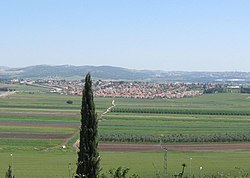Ramat Yishai
Ramat Yishai
|
||
|---|---|---|
| Hebrew transcription(s) | ||
| • ISO 259 | Ramat Yiššay | |
 |
||
|
||
| Coordinates: 32°42′12.24″N 35°9′54.36″E / 32.7034000°N 35.1651000°ECoordinates: 32°42′12.24″N 35°9′54.36″E / 32.7034000°N 35.1651000°E | ||
| District | Northern | |
| Founded | 1925 | |
| Government | ||
| • Type | Local council (from 1958) | |
| • Head of Municipality | Ofer Ben-Eliezer | |
| Area | ||
| • Total | 2,388 dunams (2.388 km2 or 590 acres) | |
| Population (2015) | ||
| • Total | 7,478 | |
Ramat Yishai (Hebrew: רָמַת יִשַּׁי, Jesse's Heights; Arabic: رمات يشاي) is a town in the Northern District of Israel, located on the side of the Haifa–Nazareth road about 4 kilometres (2.5 mi) eastern to Kiryat Tivon. It achieved local council status in 1958. In 2015 it had a population of 7,478; the vast majority of residents are Jewish.
Archaeological remnants have been found from Middle Bronze Age I (a tomb) and the Roman, Byzantine, Umayyad and Abbasid eras. Of particular interest, was a zoomorphic vessel of glass, dating to the Umayyad era. Remains from the Crusades, as well as from the Mamluk era has also been found here.
During the Ottoman era was here a Muslim village called Jeida. The village appeared as Geida on the map which Pierre Jacotin compiled in 1799.
In 1859, the village of Jeida was estimated to have 120 inhabitants, and the tillage was 20 feddans. In 1875 Victor Guérin found rock-cut cisterns here. In 1881, the Palestine Exploration Fund's Survey of Western Palestine (SWP) found that Jeida was much like Al-Harithiyah, but with houses of adobe. A spring existed 3/4 of a mile to the west. One of the most known buildings in the village is called "the Khan" (hostel in Arabic), a 1909 building with surrounding walls. The logo of the village consists of this Ottoman-era building with a palm tree next to it. The town hall flies 2 logo-on-bedsheet flags with this emblem in dark blue on a light blue and a yellow field, respectively.
...
Wikipedia


